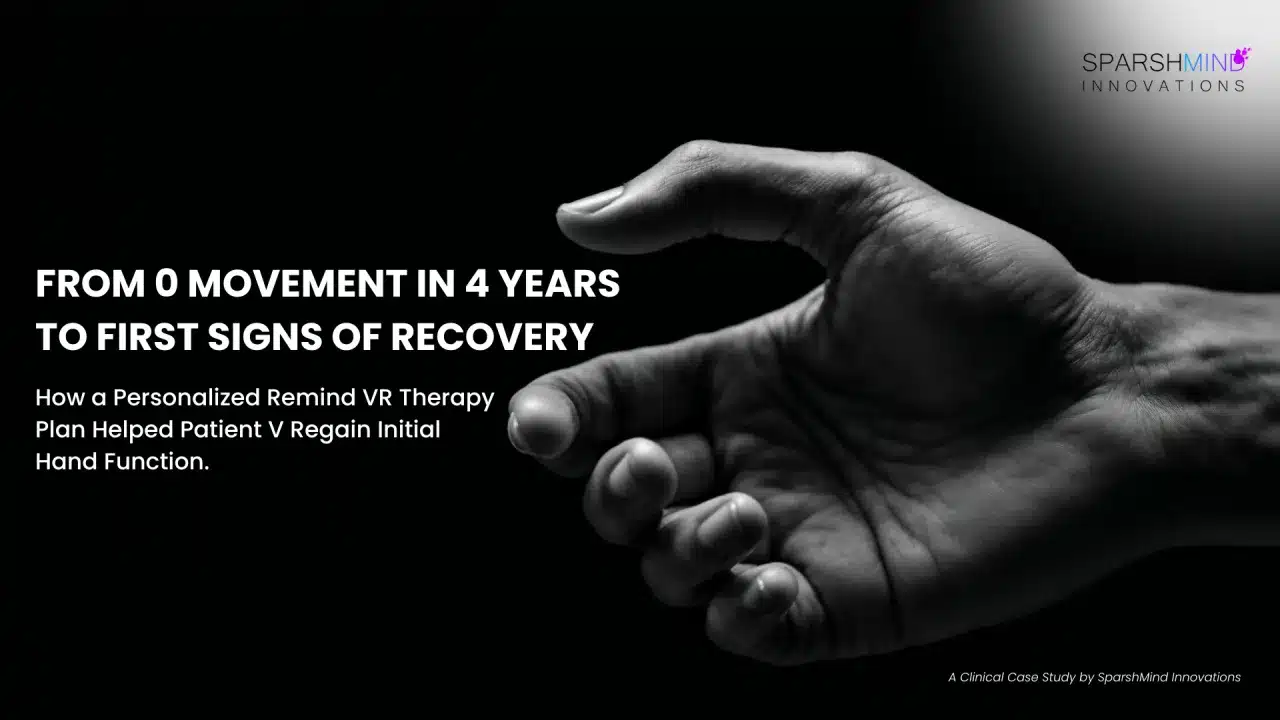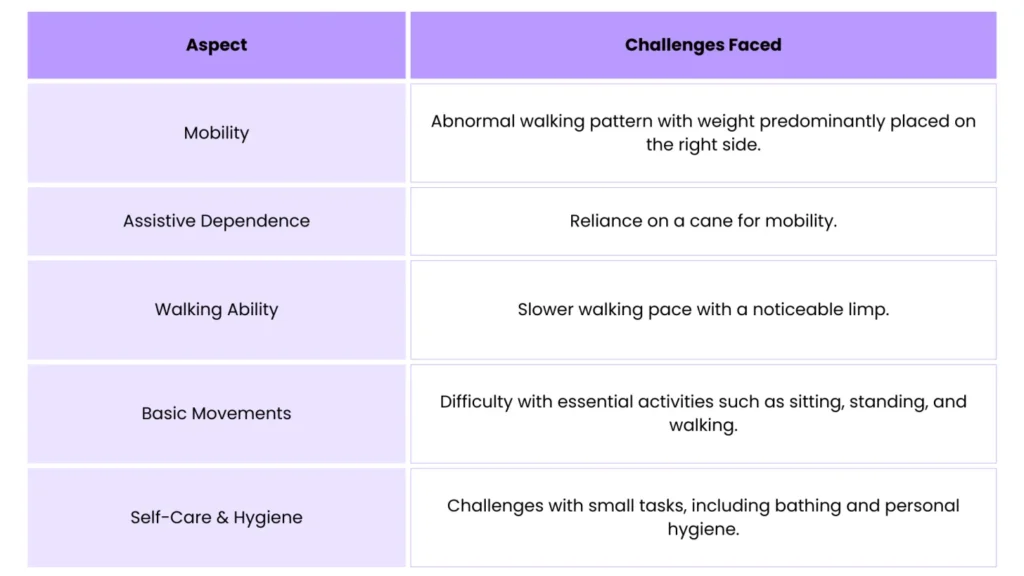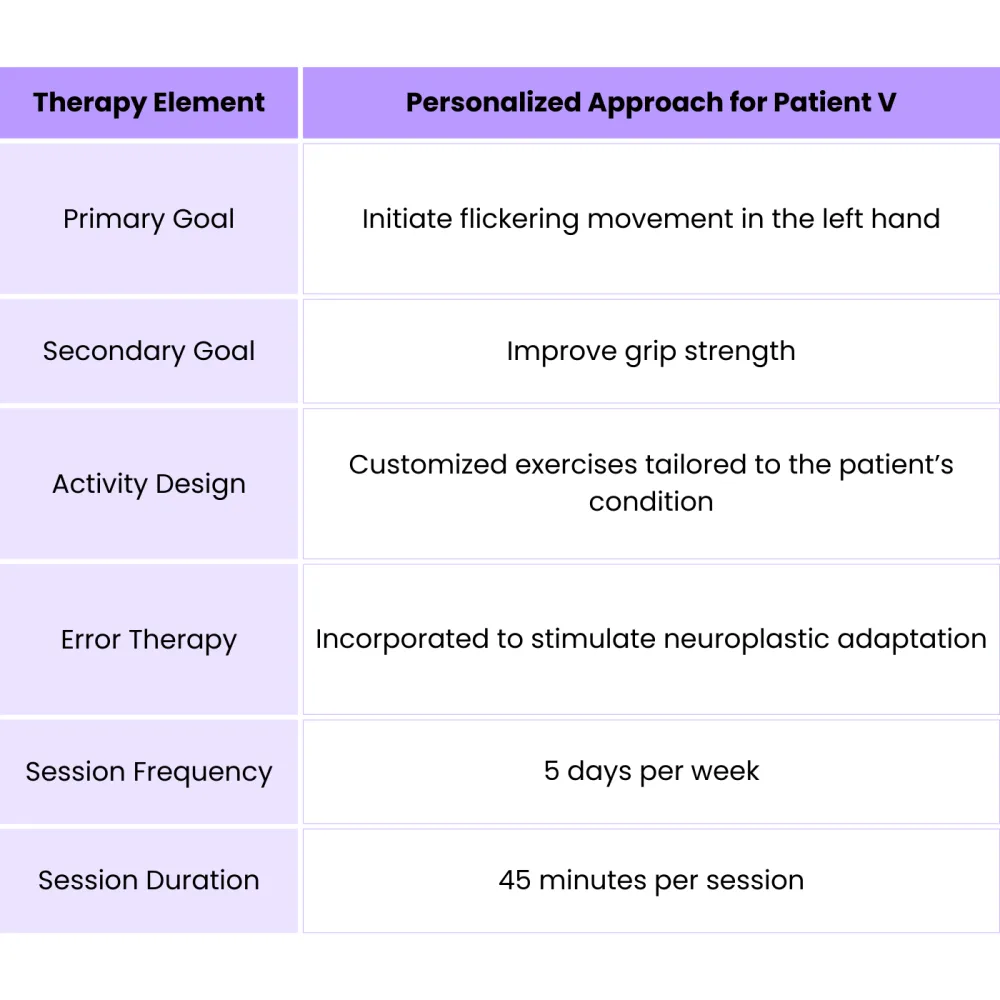Book Appointment Now

From 0 Movement in 4 Years to First Signs of Movement— How A Personalized VR Therapy Plan Helped
Patient Background
Patient V is a 45-year-old individual who suffered a stroke in 2021, resulting in complete paralysis of the left side with no flickering movement. The condition presents with full spasticity and pain during passive joint range of motion as well as assisted movements in the left hand. The patient also experiences breathing difficulties after some exercises.
Pre-Treatment Challenges
When beginning therapy, the patient demonstrated several challenges that impeded effective rehabilitation:
- Difficulty performing alternate activities together
- Requiring 3-4 minute breaks between activities due to fatigue
- Needing explicit directional instructions during activities
- Tendency to stop performing or ignore activities without proper guidance
Pre-Treatment Challenges

Previous Treatment Approaches
The patient had previously attempted treatment but discontinued after only 2-3 days due to frustration with the process.
Limitations of Traditional Therapies
Traditional therapy approaches were unsuccessful for this patient due to:
- Intolerable pain during treatment and therapy sessions
- Inability to perform sufficient repetitions
- Dislike of therapist interaction and methodology
Transition to Remind VR Therapy
The patient was introduced to Remind VR Therapy with the explicit understanding that:
- Treatment would be conducted solely through virtual reality
- No manual touch would be required
- The approach would eliminate pain during therapy

The therapy sessions were personalized with:
- Assisted activities
- Mirror therapy to stimulate the left hand
Observed Improvements
During therapy, the patient showed marked progress:
- Development of finger flickering ability
- The capability to grip the therapist’s hand with fingers
Timeline of Progress
Significant improvements became noticeable after 15-20 sessions, when the patient self-reported feeling the changes in function.
Psychological Response
The patient demonstrated a highly positive emotional response to the therapy:
- Expressed happiness with the device
- Showed excitement about regaining gripping ability
- Demonstrated hope for further recovery of left-hand function
Family and Caregiver Observations
The patient’s relative observed the improvements and expressed belief that the device would help restore movement in the left hand to pre-stroke functionality.
Comparative Efficacy
Remind VR Therapy demonstrated clear advantages over traditional approaches:
- Greater ease of use and effectiveness for this specific condition
- Integration of multiple therapeutic approaches (including mirror therapy) in a single platform
- Elimination of logistical challenges associated with traditional therapy
Unexpected Benefits
The therapy yielded additional benefits beyond the initial goals:
- Potential for increased hand-holding capability
- Progressive improvement in left-hand movement
Patient Feedback
The patient and family reported high satisfaction with the therapy:
- Easy to use
- Comfortable experience without discomfort
- No concerns about falling or other safety issues
Challenges and Adjustments
Initial challenges included:
- Difficulty understanding directions
- Lack of effort in utilizing the left hand and fingers
- Initial lack of seriousness about the exercises
These were overcome through continued guidance and as the patient began experiencing improvements.
Treatment Outcomes and Long-Term Benefits
The final outcomes of treatment included:
- Ability to grip with fingers
- Gained strength to pull hand toward the body
- Potential for further movement improvements with continued therapy
Clinical Implications
This case demonstrates the significant impact of Remind VR Therapy on neurorehabilitation, particularly its ability to:
- Decrease recovery time
- Effectively incorporate mirror therapy to stimulate muscle activity
Lessons for Future Applications
Key insights from this case include the effectiveness of mirror therapy in stimulating recovery, which could be emphasized in future VR therapy protocols.
Patient Consent & Confidentiality
This case study has been developed with the informed consent of the patient and is shared solely for educational and clinical insight purposes as part of SparshMind’s neurorehabilitation research. No personal or identifiable information of the patient has been disclosed. The privacy, dignity, and confidentiality of the patient remain our utmost priority throughout the documentation and presentation of this case.
